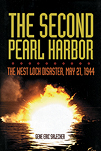
The Second Pearl Harbor: The West Loch Disaster, May 21, 1944, by Gene Eric Salecker, University of Oklahoma Press, Norman, 2014, $34.95
Military historian Gene Eric Salecker, author of Disaster on the Mississippi: The Sultana Explosion, April 27, 1865, is no stranger to naval calamities behind the battlefronts. In The Second Pearl Harbor he turns his gaze from the Civil War to World War II.
On May 22, 1944, as the U.S. Fifth Fleet was preparing for landings in the Marianas, an explosion rocked a fleet of LSTs and other amphibious assault craft concentrated in the West Loch section of Pearl Harbor, followed by a fire that raged for 24 hours. Eyewitnesses claimed the initial blast came as early as 1 p.m., though the official investigation set the time at 3:08 p.m. Three things are known for certain: 1) The explosion took everyone by surprise, 2) it originated with LST 353, and 3) the resulting fire spread via fuel drums and not ammunition.
The firestorm destroyed six LSTs, three LCTs, 17 amphibious tractors and eight 155mm howitzers. As for the human toll, the numbers finally accepted by the Navy nearly a decade later were 163 killed or missing and 396 injured. The author explains how, despite the disaster, the first landings on Saipan went off as scheduled without a hitch. He also believes that, despite the Japanese origin of many onsite workers, the explosion was accidental, not the result of sabotage. One intriguing question arose as to how Tokyo Rose knew enough about the explosion to mention it on her radio show, even though the Navy had blacked out the incident, even forbidding use of the word “disaster” in reference to it. We will probably never know the answer.
In 1994 Hawaiian officials unveiled a plaque to memorialize the victims of that terrible day. For scholars of the Pacific War, The Second Pearl Harbor will draw more attention to yet another secret page in its history.
—Thomas Zacharis




